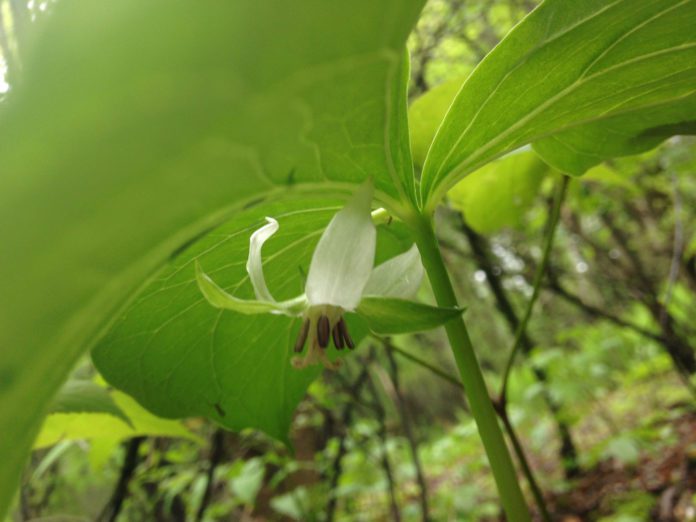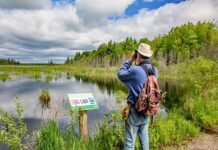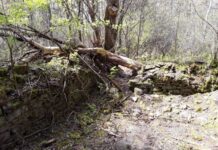submitted by Michael Whittaker
Think trillium, and the appropriately named White Trillium (Trillium grandiflorum), Ontario’s provincial emblem most often comes to mind, and then the Purple or Red Trillium (T. erectum). There are many more.
On a recent Rideau Valley Archaeology Society excursion into the Limerick South area of the Limerick Forest, Fred Schueler’s naturalist eye focused on a Northern Nodding Trillium (Trillium ceruum), adjacent to cellar holes along Dawson Lane. Although not then in bloom, the plant was recognized by its distinct leaf shape. When in flower, small, white blooms hang below the leaves.
Through reforestation and succession, Limerick Forest is naturalizing from the vacated, impoverished farmland and blowing sands of the early twentieth century.
“I’ve been campaigning for years and years to have the reforestation folks start dispersing forest floor herbs into eastern Ontario plantations,” said Dr. Schueler. “Here the herbs have gone and done it by themselves, including this species I hadn’t previously seen south of the Shield.”
There are scattered patches of White Trillium through Limerick South, but the Nodding and Red species had not been seen there before.
“Since these were seen with a few Red Trilliums, only around cellar holes, there’s also the possibility that some species survived around the houses when the rest of the landscape was hammered by grazing and tilling,” he noted.
Since Trilliums are dispersed by ants, enticed into carrying seeds by tasty growths on the corners of the seeds, they move into new habitats very slowly. The forest-floor vegetation of Limerick has been dominated by species dispersed by spores or minute, wind-borne seeds, like ferns and orchids, or are dispersed by birds, including the invasive Buckthorns now dominating the shrub layer of the forest.
There are lessons to be learned for Eastern Ontario from land-use patterns reconstructed in Massachusetts by researchers at the Harvard University Forest. Using maps showing the extent of forest from the onset of widespread European settlement and agriculture in the late-eighteenth century, they found many species of plants had not spread very far from the remnants of the primary forests into the extensive second-growth forests. The distribution patterns for many plant species still reflect the open, agricultural environment of the nineteenth century, despite the current predominance of forest cover. (Jesse Bellemare, Jesse, Glenn Motzkin, & David R. Foster. 2002. Legacies of the agricultural past in the forested present: an assessment of historical land-use effects on rich mesic forests. Journal of Biogeography, 29: 1401–1420.)
“We need to identify the most mature forests as sources of colonizing plants to appreciate the importance of the big-seeded, spring-flowering wildflowers such as Trillium, Bloodroot and Bellflower, for maturing successional forests,” said Dr. Schueler. “These species are absent from many forests like Limerick that grew on ploughed land or were grazed by cattle.”
“Compared to Limerick, a greater diversity of spring flowers are present in the woods of the Ferguson Forest Centre, where the steep banks of the river apparently provided a refuge,” he notes. “The re-introduction of these species, from nearby surviving stocks should be seen as the next step after the tree-planting, so widely done in the twentieth century.”
Spring species are ecologically important because they retain nutrients from snowmelt that would otherwise be lost to the forest ecosystem while the still dormant trees aren’t fully metabolically ‘awake.’
In the greater Ottawa Valley, Nodding Trillium is found scattered in very moist locations, and Facebooked botanists said they had seen it near Caintown (north of Mallorytown), and near Martintown, in Stormont, Dundas & Glengarry County.
The Rideau Valley Archaeology Society will continue its assessment of former home sites in the Limerick Forest, and in addition to taking measurements of the ruins, will be looking for introduced plants, and native plants that may have persisted, as these Trilliums seem to around farmsteads.
Cutline: The Nodding Trillium is native to northeastern North America on rich, moist soils in broadleaf and coniferous woodland from Newfoundland to southern Saskatchewan, and to northern Virginia and Iowa. Photo provided by Dr. Fred Schueler.









